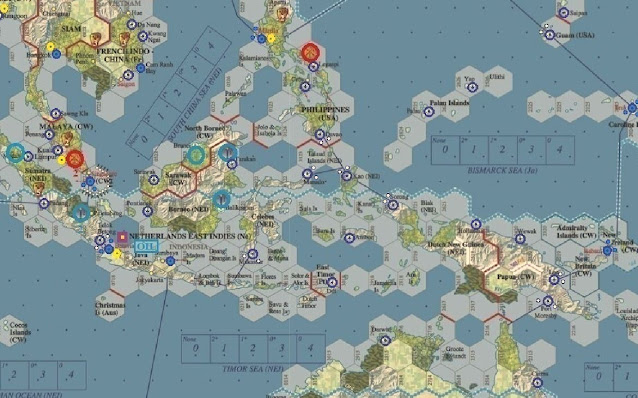All of this was a single phase, in one turn, of a scenario in what the Guinness Book of World Records names the largest commercially available board game ever published. World in Flames it's called. Originally released in 1985, it's seen multiple optional additions, fixes, expansions and editions. We bought this for our third oldest on his 21st birthday last year. He had wanted the original release for years, but I was unable to find an intact copy for anything close to a reasonable price. At least a copy with a guarantee it was intact.
Instead, I found the grand slam complete deluxe collector's edition from a few years ago that combines pretty much all of the subsequent editions and expansions from over the years. We figured it being his 21st birthday, the cost was acceptable. Plus it was brand new and never opened! And boy was it - big.
Taken together, if all expansion maps are used, along with the additional charts and tables, it would require almost two 5' x 9' ping pong tables to contain it all, with scant space left over. In addition, if combined, there are almost 10,000 game pieces (counters or chits) for use in both the game as well as informational charts. Even the basic game, all extras stripped away, uses over 4,000 pieces. For the grand campaign scenarios, the recommended set-up time can run between two to three hours. That's the set-up time, not the game time proper.
This is because the game sets out to accomplish a simple task: recreate the entire Second World War. All of it. From the importance of Edward R. Murrow's reports from London to Operation Barbarossa. From the vast naval clashes of the Pacific to special operations and intelligence gathering and espionage. From fifth column and partisans to the intricate diplomatic dances heading into the war years, especially regarding the all important entry of America into the conflict. In two thick instruction manuals and a half dozen supplemental rulebooks, it sets out to show it all.
And does it ever. Though I would lie if I said it was all peachy keen. I still consider Empires in Arms to be the most perfect war game ever. In terms of mind breaking complexity, that would go to Struggle of the Nations. For its scale, the Battles of Waterloo is still my favorite.
But the sheer bulk force of a game that seeks to recreate in its entirety the biggest and most destructive conflict in human history is impressive. There are flaws to be sure. I think I'll touch on those first. The instructions were written by someone with a passion for something, but certainly not writing instruction manuals. They're a mess. The above mentioned marine units have special features, including the ability to hop across water separating two hexes without need of naval counters Well, you have to read through hundreds of pages to find five different parts of the manuals to learn that and other specialties. It doesn't bother putting things into one clear and obvious place. We won't even get into the stupidly pointless examples it often gives. That's why my son and I putting our heads together are still trying to figure out the game's finer points after eight months of trying.
 Another bugaboo is that the scales are all over everywhere. The European map, the Pacific map, the African and Americas maps are all of different scales. Which can be maddening. More annoying is that unit counters themselves are all over the place. Land counters represent everything from divisions up to army groups. Except for divisions, however, there are no practical differences. It's mostly aesthetics. That's why one wag on a forum said if it's tough wrapping your mind around an army corps descending on tiny Kwajalein Atoll, just say 'elements of'' (hence my wording above).
Another bugaboo is that the scales are all over everywhere. The European map, the Pacific map, the African and Americas maps are all of different scales. Which can be maddening. More annoying is that unit counters themselves are all over the place. Land counters represent everything from divisions up to army groups. Except for divisions, however, there are no practical differences. It's mostly aesthetics. That's why one wag on a forum said if it's tough wrapping your mind around an army corps descending on tiny Kwajalein Atoll, just say 'elements of'' (hence my wording above). On the other hand, ships - from light cruisers on up - represent each and every ship in the major navies of WWII. So when the Brooklyn went down in that battle, that meant the Brooklyn, not a counter representing X number of cruisers (though each ship counter is considered to include a couple destroyer and auxiliary ship escorts - just to cross ts and dot is for figuring larger task forces).
On the other end, air counters mean almost nothing. Ostensibly each counter represents from 200 to 500 of the respective planes shown on the counter. But none of that really means anything. In the Guadalcanal campaign, there were not 300 to 400 B-17s flying about. Likewise, most air raids over Europe had more than a hundred or so bombers and fighters. Nothing really makes sense of the scale. Only carrier planes - if a naval supplement for the game is used - come close. Using those rules, the Akagi, for example, sports plane counters representing roughly 60-70 planes on board, which is about correct (it could hold 60 planes historically).
That might not bother some, but things like that bug me. I can suspend belief, or obsession about trivial things, to a point. But unit counters meaning so many different things converging on the same battle, that bugs me. I simply developed my own scale to help the counters make sense when the given scales don't work. That way B-17s are measured in the tens and not hundreds over those South Pacific islands. For a game this in depth striving for its level of historical accuracy, I can't imagine why a little more time and effort wasn't added to better accommodate the scales.
Finally, the maps. They may be impressive, but they're also a nightmare, especially for my fading eyesight. The maps have hexes overlaid on all land areas. Sea zones are a different animal altogether. In each hex can be a variety of bits and pieces of information crucial to the game. That's wonderful in itself, but at times very unwieldy. For instance:
That's a copy of the maps I downloaded and added graphic embellishments to in order to draw out key features. I have that on my phone so I can use it during play. There is just no way I can lean over the five foot wide table and see the small images, writing and numbers. There's too much information. That's why there are no 'ownership' counters showing who owns what. You make notes or keep it in your head. Trying to add something like that would push over the top an already over the top playing map.
It looks like this post went longer than planned, and almost all negative. What do you expect for a post musing on the most stupidly over the top game ever sold? I guess I'll have to invoke Henry II from the film Becket: I have confided in you my hate, not my love for this game. I'll do that in a follow up post. Till then.












.jpg)






